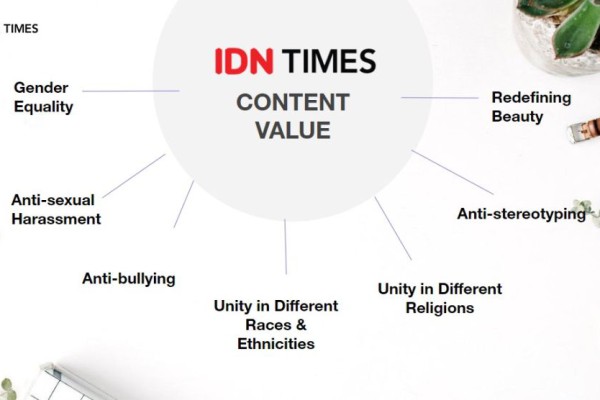Media’s Roles to Educate and to Provide Balanced Opinion-Reportages
 7 Pilar Konten IDN Times
7 Pilar Konten IDN Times
Follow IDN Times untuk mendapatkan informasi terkini. Klik untuk follow WhatsApp Channel & Google News
Bad News is Good News. Situations like this are often still faced by journalists and the media when they work on covering religious issues, including inter-religious issues. One reason is the news peg. Actuality. Religious issues are widely covered when there is a conflict with a religious background. Is there conflict between groups within religion, for example the majority Islamic group's rejection of Shia or Ahmadiyah adherents? Or conflicts between religious adherents, as happened in Ambon in 1999.
Conflicts between religious adherents were actually triggered by economic and socio-political disparities. In such a situation, the number of readers/viewers of news related to religious issues increases. When well-known anti-islamic Dutch politician Geert Wilders, won a landslide victory in last year's election, the media in Indonesia and around the world covered it widely. What impact will this have on the Islamic community in the Netherlands? Where there are many people of Indonesian descent?
Outside of conflicts, journalists are also reluctant to cover religious issues. The reason is fear of correctness, fear of criticism, especially from adherents of the majority religion. There are always groups that are small in number, but speak out vocally whenever they find content that is considered critical or not in accordance with their group's opinion. Not infrequently, these groups come to media offices to express their objections.
Covering diversity for example, only received attention when the Jyllands-Posten Muhammad cartoons controversy occurred, beginning after the Danish newspaper Jyllands-Posten published 12 editorial cartoons on 30 September 2005, most of which depicted Prophet Muhammad, a principal figure of Islam. Muslim groups in Denmark complained, and this eventually led to protests around the world, including violence and riots in Muslim countries, including in Indonesia. Thank God, the protests in Indonesia went peacefully.
This incident was the background for the Global Intermedia Dialogue, a joint initiative of the Indonesian Ministry of Foreign Affairs and the Norwegian Government, to discuss on how the media should cover diversity issues, including religious issues. GIMD was carried out in 2006 in Oslo, then in 2007 in Bali, Indonesia. In 2008 it was held again in Oslo. I was invited to take part in three GIMD events.
Training on how to cover religious issues and diversity issues is often carried out in various countries, including Indonesia. In various seminars, conferences and workshops, one of the things that stood out was the importance of faith literacy. Cultivating faith literacy becomes imperative for fostering harmony, dialogue, and mutual respect.
At its core, faith literacy entails more than the ability to recite religious texts or identify symbols; it embodies a deep comprehension of the beliefs, practices, and experiences that shape individuals' spiritual journeys. It acknowledges the multifaceted nature of faith, encompassing not only organized religions but also personal philosophies, ethical frameworks, and cultural traditions.
In today's globalized world, characterized by migration, multiculturalism, and interconnectedness, faith literacy emerges as a cornerstone of social cohesion and peaceful coexistence. Not to mention that we live in a digital era, where a tsunami information surrounds every second.
One of the fundamental aspects of faith literacy is the recognition of the complex interplay between religion, culture, and socio-political dynamics. It involves critically examining the historical and contextual factors that shape religious beliefs and practices, as well as their impact on individuals and communities. By acknowledging the nuances of religious identity and expression, faith literacy promotes a more nuanced understanding of religious phenomena, mitigating prejudices and fostering intercultural dialogue.
Education plays a pivotal role in cultivating faith literacy from an early age. By incorporating religious studies into school curricula, educators can equip students with the knowledge and skills to navigate the complexities of religious diversity with sensitivity and respect. Moreover, interfaith initiatives and dialogue programs provide platforms for individuals from different religious backgrounds to engage in meaningful exchanges, dispelling misconceptions and building bridges of understanding.
In addition to formal education, the media and popular culture wield significant influence in shaping perceptions of religion and spirituality. Therefore, promoting accurate and nuanced portrayals of diverse religious traditions in the media can contribute to enhancing faith literacy and countering stereotypes. Furthermore, fostering collaboration between religious leaders, community organizations, and policymakers can create inclusive spaces for dialogue and cooperation, promoting social cohesion and collective well-being.
I believe this is the background on why the Indonesian Ministry of Foreign Affairs involved representatives from Media in bilateral interfaith activities and multilateral events. I was invited to represent the Indonesian media in a number interfaith dialogue events held by MOFA, including in Manila Phillipines, Perth Australia, Bandung and Jakarta, Moscow Russia and Helsinki Finland.
How important is the role of the media? The media has at least two roles: Educator and Arbiter of Balanced Reporting
Editor’s picks
The media landscape in Indonesia is very interesting. According to Press Council data, there are 43,000 media, almost all of which are online media. It is difficult to get an exact data on the number of journalists. The ability of organizations and media companies to train journalists is very minimal. The quality of journalists is a big problem. Especially in covering diversity issues. The workshops held by SEJUK are very useful and helpful, but they are far from enough to equip journalists with the ability to produce quality journalistic work.
In the contemporary landscape, the media serves as both an educator and a purveyor of balanced opinion and reportage, wielding significant influence in shaping public discourse and perceptions. With the advent of digital technology and social media platforms, the dissemination of information has become more rapid and pervasive than ever before, underscoring the critical importance of responsible journalism and media literacy.
I will explore the dual role of the media in educating the public and providing balanced opinions and reportages, as well as the challenges and opportunities inherent in fulfilling these roles.
Firstly, as an educator, the media plays a pivotal role in informing the public about current events, issues, and developments, thereby facilitating civic engagement and informed decision-making. Through news reports, documentaries, and investigative journalism, the media provides valuable insights into the complexities of the world, shedding light on diverse perspectives and voices. Moreover, by contextualizing information and presenting it in an accessible manner, the media empowers individuals to critically analyze and interpret the news, fostering media literacy and civic awareness.
However, the media's role as an educator is not without challenges. In an era marked by information overload and the proliferation of hoaxes and misinformation, distinguishing between credible sources and falsehoods has become increasingly difficult for audiences. Furthermore, sensationalism, bias, and agenda-driven reporting can distort the truth and undermine the public's trust in the media. Therefore, journalists and media organizations bear a responsibility to uphold ethical standards of accuracy, impartiality, and transparency, thereby safeguarding the integrity of their reporting and enhancing public trust.
In addition to its role as an educator, the media serves as an arbiter of balanced opinion and reportage, providing a platform for diverse perspectives and fostering dialogue and debate. Through opinion pieces, editorial content, and panel discussions, the media facilitates the exchange of ideas and viewpoints, enriching public discourse and promoting pluralism. Moreover, by presenting multiple sides of a story and fact-checking claims, the media helps audiences form more informed and nuanced opinions, thereby contributing to a vibrant and democratic society.
Nevertheless, achieving balanced reporting poses its own set of challenges for the media. Commercial pressures, editorial biases, and political agendas can influence the framing and presentation of news stories, leading to a lack of objectivity and fairness. Moreover, the rise of echo chambers and filter bubbles in digital media ecosystems can exacerbate polarization and limit exposure to diverse viewpoints, hindering efforts to foster informed and constructive dialogue. Therefore, media organizations must strive to uphold journalistic integrity and independence, while also embracing diversity and inclusivity in their coverage.
At IDN Times, we try to always pay attention and cover minority, the voiceless, in religion and faith. Last year, I went to UK, to cover Jalsah Salana, the biggest annual gathering Jamaah Islamiyya Muslim Community.
In conclusion, the media's dual role as an educator and arbiter of balanced reporting is integral to the functioning of democratic societies. By providing accurate, credible, and accessible information, the media empowers individuals to engage meaningfully with the world around them and participate in democratic processes. Moreover, by fostering dialogue, diversity, and pluralism, the media contributes to a more informed, tolerant, and resilient sociey. As we navigate the complexities of the digital age, it is imperative that media organizations uphold the highest standards of journalism ethics and embrace their responsibility to educate and inform the public impartially and responsibly.
Apart from referring to the Indonesian Journalism Code of Ethics and guidelines for covering diversity and religion, at IDN Times, we refere to 7 pillars in producing content: 1. gender equality, 2. unity in different races and ethnicities, 3. unity in different world, 4. unity in different religions, 5. anti sexual harassment, 6. anti bullying, 7. anti stereotyping, dan 8. redefining beauty. Our media tagline is #DiversityisBeautiful.
Entering our 10th years as digital media, one stop content platform targeting millennials and gen Z, we are still learning how to carry out our roles and functions as media that upholds the public interest, including inter-religious and diversity issues. Two years ago we invited The Media Project, US, to train IDN Times journalists (and Indonesia Women Journalist Forum, I lead on) how to cover diversity and religion issues in a mobile journalism format. In this journey, we also believe that inspiring stories, interfaith stories, can attract the attention of many audiences. Good News can be a Good News too.
"Presented at the event of The 9th Interfaith Dialogue, by KBRI Den Haag, 14th May 2024"
Baca Juga: Hari HAM Sedunia, Indonesia Angkat Tema Harmoni dalam Keberagaman

